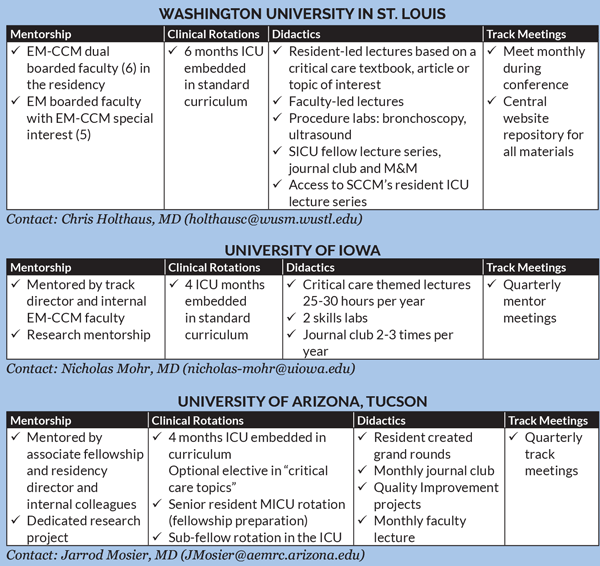With these examples and suggestions, you can help prepare or improve your own residency's critical care track.
Care of the critically ill patient is central to the education of the emergency medicine resident. Each residency delivers this education to their residents through its own combination of clinical rotations and various other educational experiences. To meet the needs of those residents with a particularly strong interest in critical care medicine, some programs have created critical care tracks within the residency curriculum. Many of these tracks are created and run by residents.
“How to” create a critical care track at your EM residency — the bullet points:
- Find faculty mentors and research opportunities in critical care.
- Work with departments of surgery, medicine, anesthesiology, and neurology to establish ICU rotations.
- Create extracurricular didactic opportunities such as journal clubs, skills labs, simulation, lectures.
- Formally meet with members of the track regularly.
With the formalized process for co-sponsored board examinations established and under way, the critical care fellowship is becoming more and more popular and competitive among EM residents. Currently, though, there are three ACGME board-eligible critical care fellowship pathways: anesthesiology, surgery, and internal medicine. The neurological critical care fellowship, also available to EM residents, offers certification through the United Council for Neurologic Subspecialties (UCNS). Internal medicine-based fellowships are unique because they require six months of internal medicine rotations, three of which must be in a medical ICU, to be completed during residency prior to starting the fellowship. The surgical, anesthesia, and neurological critical care fellowships do not require completion of additional clinical prerequisites during residency. EM residents entering the surgical critical care fellowship need to complete one year as an advanced preliminary surgical resident, however this is completed during the first year of fellowship.
Creation and completion of residency critical care tracks can help enormously to make residents more competitive applicants through clinical ICU experience, fellowship prerequisites, letters of recommendation, mentorship, and experiences in research and didactics. Additionally, the presence of a critical care track helps to increase the exposure of residents to critical care as a specialty career option.
Critical care tracks are not only of interest to residents planning to pursue a critical care fellowship, but also residents who are simply interested in additional, focused education on caring for the critically ill.
Although there is no established or agreed upon content for what a critical care track should contain, successful tracks seem to frequently have a few similar components: mentorship with critical care faculty, research support, clinical rotations caring for critically ill patients, critical care didactic curriculum, and scheduled track meetings.
Mentorship is key to successful career navigation for the potential EM intensivist. Some residencies have readily available critical care mentors on staff; however, the pool of EM-critical care medicine (EM-CCM) faculty is small and many institutions do not have mentors who are easily accessible. To help address this, the American College of Emergency Physician's (ACEP) Critical Care Section has created the Virtual Mentorship Program that matches residents with EM-CCM mentors around the country (to participate, visit http://www.emccmfellowship.org/mentorship.php). Mentors are essential to help answer questions about career paths, as clinical critical care instructors and knowledgeable teachers for didactic curricula, and to recruit residents to participate in critical care research.
Clinical rotations for exposure to the critically ill patient can be created in the ED with resuscitation electives, in departments with ED ICUs, or in inpatient ICUs. Experience in the ICU not only as an intern but also later in residency as a senior resident is the ideal plan for the well-rounded, longitudinal critical care education and creates a strong foundation necessary to prepare the EM resident for his/her role as a fellow. The ACGME has limitations on EM senior residents supervising interns of other specialties, but creating a combined senior and intern EM team within the ICU is one solution to this problem. Often this is the best place to obtain letters of recommendation for future fellowship applicants.
The didactic curriculum for a critical care track has many creative options. Thematic critical care journal clubs, lectures given by residents in the track, EM-CCM faculty lectures or invited speakers during conference or separate meeting times, simulations and skills nights (ventilator trouble shooting, cadaver labs, ultrasound, etc.), and critical care themed morbidity and mortality conferences are some examples. Often, EM residents can also attend educational sessions for critical care fellows at their home institution.
Regularly meeting as a track is essential for creating a sense of community among the members and ensuring the strength and sustainability of the track. It is an opportunity for development of leadership and administration skills when residents design the track and continuously modify and improve it. It is also a way to facilitate involvement in national meetings including the ACEP Critical Care Section, Emergency Medicine Residents' Association Critical Care Division, Society of Critical Care Medicine (SCCM), and other critical care organizations. During these track meetings, residents and faculty can communicate the regional and national happenings of these organizations to their home residency.
If your home institution does not currently have a critical care track, consider creating one. Often the strongest and most sustainable tracks are resident created and run. Represented here are a few examples from around the country of particularly successful critical care tracks. Hopefully with these examples and suggestions, you can help prepare or improve your own residency's critical care track.
EMRA Critical Care Division: www.emra.org/committees-divisions/critical-care-division
ACEP Critical Care Section: www.acep.org/criticalcaresection
EM-CCM Virtual Mentorship: www.emccmfellowship.org/mentorship.php




